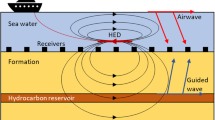Abstract
Research on gas hydrate has increased recently as an alternative to fossil fuel. This study of marine controlled source electromagnetics (CSEM) is motivated by this increase, particularly in deep waters, and examines representative models. We present 2D models and test their efficacy in detection and characterization of gas hydrates. Earlier modeling studies used a horizontal transmitter to study the CSEM response—two electrical and one magnetic component—for resistive subsurface layers. Here we use six components—three electrical and three magnetic—and show that the proposed method reduces ambiguity in interpretation. Additionally, we show results utilizing the transmitter dipole in a borehole and receivers at the sea bottom. We found that CSEM response from a vertical transmitter helps us characterize resistive layers more confidently than from a transmitter moving horizontally at sea bottom. We conclude that in a complex environment, combining horizontal and vertical movements of the transmitter with sea-bottom receivers helps us delineate the subsurface structure more clearly and may help reduce drilling costs. Our models closely match the gas hydrate region in the Gulf of Mexico—Walker Ridge Block-313. Although this study examines gas hydrate, the methodology is applicable to other areas—for example, in monitoring gas diffusion at subsurface depths, which may help in CO2 sequestration.









Similar content being viewed by others
References
Backus MM, Murray PE, Hardage BA, Graebner RJ (2006) High-resolution multi-component seismic imaging of deepwater gas-hydrate systems. Lead Edge 25:578–596
Chave AD (2009) The electromagnetic fields produced by marine frequency domain controlled sources. Geophys J Int 179:1429–1457
Chen J, Hoversten GM, Vasco D, Rubin Y, Hou Z (2007) A Bayesian model for gas saturation estimation using marine seismic AVA and CSEM data. Geophysics 72:WA85
Constable S, Srnka LJ (2007) An introduction to marine controlled source electromagnetic methods for hydrocarbon exploration. Geophysics 72(2):WA3–WA12
Constable S, Weiss CJ (2006) Mapping thin resistors and hydrocarbons with marine EM methods: insights from 1D modeling. Geophysics 7(2):G43–G51
De Angelo MV, Murray PE, Hardage BA, Remington RL (2008) Integrated 2D 4-C OBC velocity analysis of near-seafloor sediments, Green Canyon, Gulf of Mexico. Geophysics 73(6):B109–B115
Edwards RN (1988) Two-dimensional modeling of a towed in-line electric dipole–dipole sea-floor electromagnetic system—the optimum time delay or frequency for target resolution. Geophysics 53:846–853
Edwards RN (1997) On the resource evaluation of marine gas hydrate deposits using sea-floor transient electric dipole–dipole methods. Geophysics 62:63–74
Ellingsrud S, Eidesmo T, Johansen S, Sinha M, MacGregor L, Constable S (2002) Remote sensing of hydrocarbon layers by seabed logging _SBL: results from a cruise offshore Angola. Lead Edge 21:972–982
Ellis M, Evans RL, Hutchinson D, Hart P, Gardner J, Hagen R (2008) Electromagnetic surveying of seafloor mounds in the Gulf of Mexico. Ma Pet Geol 25(9):960–968
Hardage BA, Murray P, Sava D, Backus MM, Remington R, Graebner R (2006) Evaluation of deepwater gas-hydrate systems. Lead Edge 25:572–576
Hutchinson DR (2008) USGS gas hydrate studies in the northern Gulf of Mexico, in USGS Gulf coast science conference and florida integrated science center meeting; proceedings with abstracts, US Geological Survey. Open File Report, p 59
Key K (2009) 1D inversion of multi-component, multi-frequency marine CSEM data methodology and synthetic studies for resolving thin resistive layers. Geophysics 74(2):F9–F20
Li Y, Key K (2007) 2D marine controlled-source electromagnetic modeling: part 1—An adaptive finite element algorithm. Geophysics 72(2):WA51–WA62
McGregor L, Andreis S, Tomlinson J, Barker N (2006) Controlled source electromagnetic imaging on the Nuggets-1 reservoir. Lead Edge 25:984–992
Orange A, Key K, Constable S (2009) The feasibility of reservoir monitoring using time-lapse marine CSEM. Geophysics 74(2):F21–F29
Sava DC, Hardage BA (2006) Rock physics characterization of hydrate-bearing deepwater sediments. Lead Edge 25:616–619
Sava D, Hardage BA, Murray P, DeAngelo M (2008) Rock-physics joint inversion of resistivity-log and seismic velocity for hydrate characterization. In SEG Las Vegas annual meeting 1724–1728
Scholl C, Edwards RN (2007) Marine down hole to seafloor dipole–dipole electromagnetic methods and the resolution of resistive targets. Geophysics 72(2):WA39–WA49. doi:10.1190/1.2434775
Sinha MC, Patel PD, Unsworth MJ, Owen TRE, MacCormack MGR (1990) An active source electromagnetic sounding system for marine use. Mar Geophys Res 12:29–68
Srnka L, Carazzone JJ, Ephron MS (2006) Remote reservoir resistivity mapping. Lead Edge 25:972–975
Weitemeyer K, Constable S, Key K, Behrens J (2006) First results from a marine controlled-source electromagnetic survey to detect gas hydrates offshore Oregon. Geophys Res Lett 33:L03304
Yutaka S, Meju MA (2009) Useful characteristics of shallow and deep marine CSEM responses inferred from 3D finite-difference modeling. Geophysics 74:F67–F76
Zach JJ, Brauti K (2009) Methane hydrates in CSEM surveys—analysis of a recent data example. Geophy Pros 57:601–614
Acknowledgments
This work was carried out under Exploration Geophysics Laboratory project funding from the Bureau of Economic Geology (BEG), The University of Texas at Austin. The first author would like to thank the Director, BEG, for supporting as a visiting scientist. Generous support from the Scripps Institution of Oceanography in sharing its CSEM codes for this research is gratefully acknowledged. Figures were drafted by Jana Robinson. Publication of the present study is authorized by the Director, BEG.
Author information
Authors and Affiliations
Corresponding author
Rights and permissions
About this article
Cite this article
Harinarayana, T., Hardage, B. & Orange, A. Controlled-source marine electromagnetic 2-D modeling gas hydrate studies. Mar Geophys Res 33, 239–250 (2012). https://doi.org/10.1007/s11001-012-9159-z
Received:
Accepted:
Published:
Issue Date:
DOI: https://doi.org/10.1007/s11001-012-9159-z




